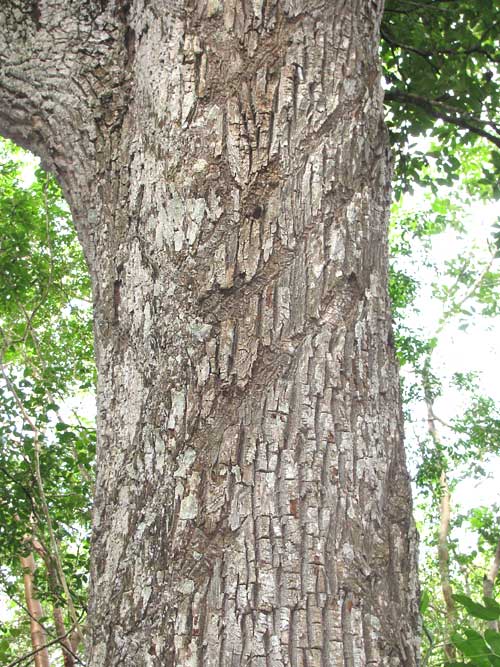Excerpts from Jim Conrad's
Naturalist Newsletter
from the May 12, 2008 issue written a bit east of Venustiano Carranza in the Central Valley of Chiapas, México
CHICOZAPOTE FRUITS
Chicozapote trees bear alternate, simple, smooth-margined (entire), leathery leaves, often clustered toward branch tips. Typically they exude white latex (like Chicozapote's chewing-gum base) when injured. Mature Chicozapote fruits are among the most delicious of all tropical fruits. An immature Chicozapote with leaves is shown below:

from the October 27, 2008 issue written in Yokdzonot, Yucatán, México
GIANT CHICOZAPOTE/ SAPODILLA TREES
Some tree trunks were about 3.5 feet in diameter (1 m), several times more massive than other trunks in the area. That's one below:

Even before checking the leaves high in the canopy I knew which tree this was because of the diagonal scars across its trunk. It's MANILKARA ZAPOTA, in English often called the Sapodilla or Chicle Tree, and in Spanish Chicozapote. It's one of the most famous and appreciated of all trees in this part of the world not only because its fruit is one of the sweetest, most cherished of all tropical fruits, but also because the white latex that oozes from its slashed trunk once was in much demand as the base for chicle, from which chewing gum once was made. Now most gum is made from synthesized material.
Back in the 70s when I served as naturalist on river tours in Guatemala's northern "Petén Jungle" Sapodilla was common in the forest. Here I'd assumed that this far north there'd be too little rainfall for the species to occur naturally but an old-timer tells me that Sapodillas occur in several spots throughout the most isolated forest, and that once it was more common. I suspect that we're on the very northern boundary of Sapodilla's distribution here. The giant -- relatively speaking -- trunk in the picture is a relict from before the current destruction.
Back in the 70's, the most isolated parts of the Petén's forest were accessible by "chiclero trails" -- half-visible paths men used to reach the most isolated parts of the forest, where they'd wander off the trails to collect latex from Sapodilla trees. Sometimes during my own long hikes there I've stayed in chiclero camps where the men gathered at night to boil their latex in big kettles until they could mold it into heavy, slate-gray bricks imprinted with their own identification marks and symbols. The bricks were sold to the Japanese, who were fussier about their chewing gum than other nationalities.
In heavy tropical rainforest it can be hard to see more of a tree than its trunk. Back then the best way to identify a Sapodilla tree was by its slashes. No matter how far from a trail a tree grew, it always bore those scars. I don't know if chicleros still gather latex today, or if the Japanese still demand extra-good chewing gum.